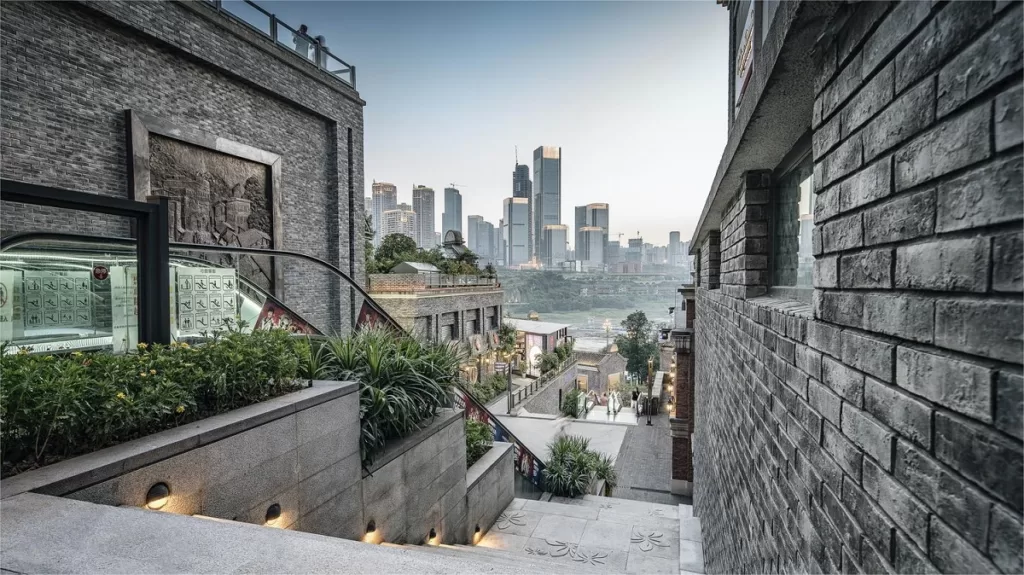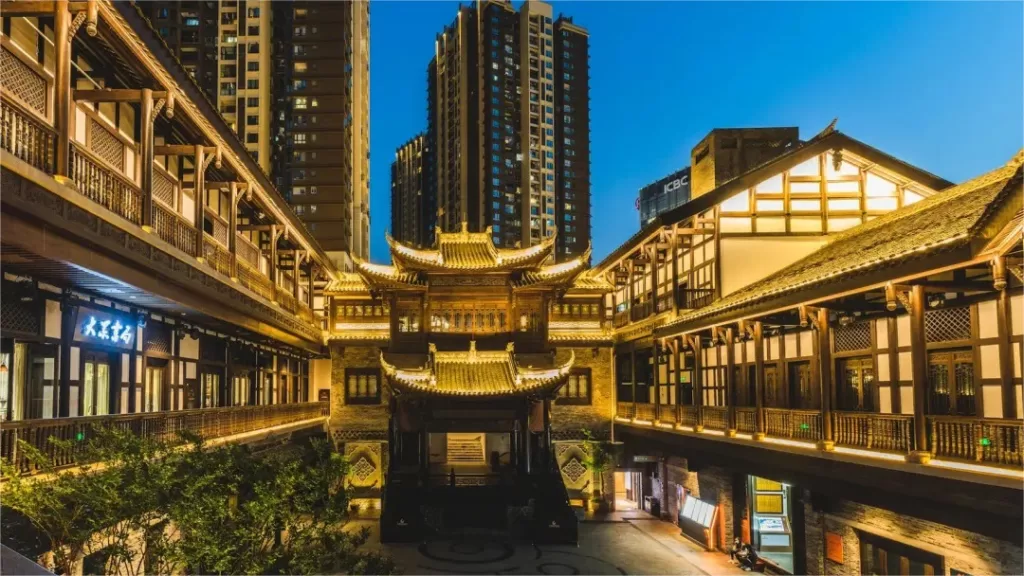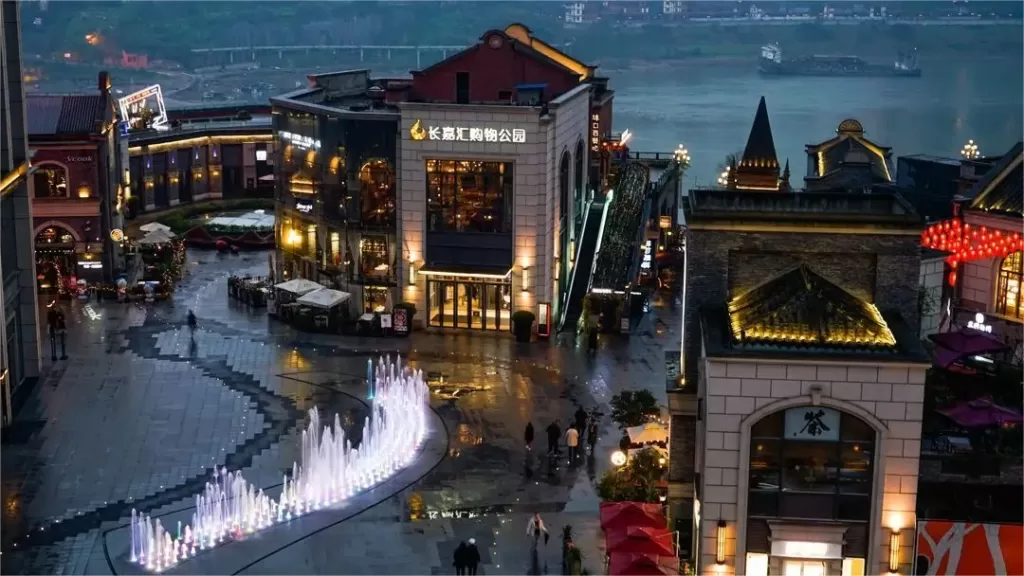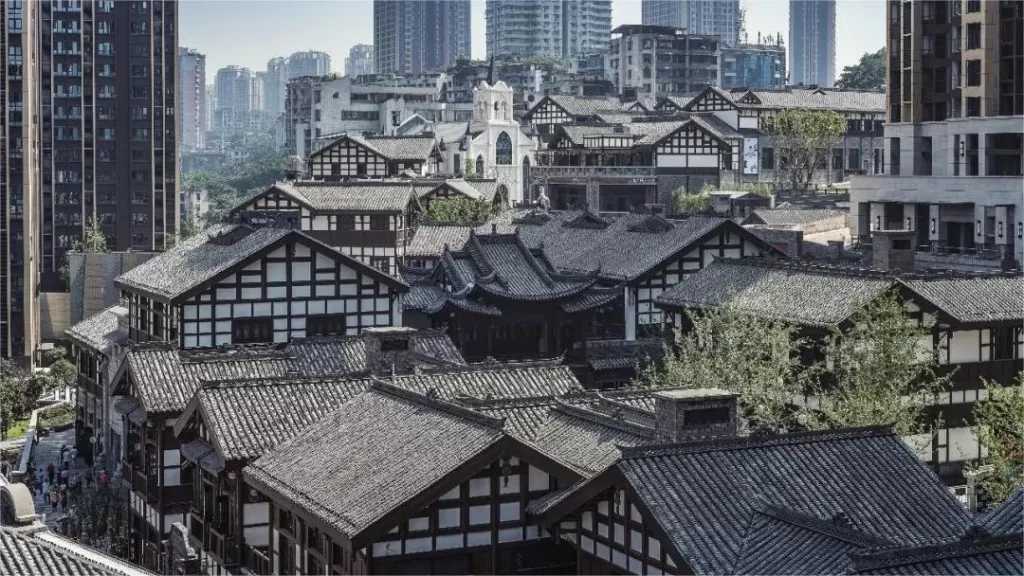Danzishi Old Street - Ticketpreise, Öffnungszeiten, Verkehrsmittel und Highlights


Danzishi Old Street (弹子石老街), once a renowned waterfront port in Chongqing in the southwestern region of China, holds a special place in history. With its roots deeply intertwined with the opening of Chongqing to the world, this street is a unique blend of a century-old heritage and a modern urban landscape, offering a comprehensive experience of history, culture, sightseeing, leisure, entertainment, and shopping. It is situated along Nanbin Road, which is often referred to as the “the Bund in Chongqing.”
Stretching for about one kilometer, with an elevation difference of approximately 80 meters over nine levels of slopes, Danzishi Old Street takes you on a journey through the distinctive Sichuan-style streets, lanes, and courtyards. Along the way, you’ll encounter a myriad of traditional “stilted buildings” that are scattered throughout the area.
According to legend, the name “Danzishi” Old Street has a fascinating origin. It is said that Great Yu married a woman from Tu Mountain on the southern bank of the river. Shortly after their marriage, Great Yu embarked on his mission to control the floods and, despite passing by his home three times, he never returned. Tu Shan, his wife, longed for her husband and stood by the riverside calling for him. Over time, her yearning transformed her into a massive riverside stone, known as the “Husband’s Return Stone” or “Calling-Back Stone.” When Great Yu finally returned from his water management duties and saw the stone, he cried out “Qi,” and the stone responded by opening, revealing a plump child who became the first ruler of the Xia Dynasty, named Xia Qi. The area near this stone was then named “Danzishi,” which, over time, evolved into the name of the old street as we know it today.
Inhaltsübersicht
- Grundlegende Informationen
- Standort und Transport
- Herkunft des Namens
- Highlights of Danzishi Old Street
- French Navy Barracks (法国水师兵营)
- Customs Stone (海关石)
- Yingyue Pool (映月池)
- Riverside Viewing Platform (观江平台)
- Madame Tussaud’s Wax Museum (杜莎夫人蜡像馆)
- Chongqing Marine Exploration Center (重庆海洋探索中心)
- Danzishi Square (弹子石广场)
- Qingyun Bridge (青云桥)
- Lichuan Ship (利川号)
- Wang Family Mansion (王家大院)
- Xia Family Mansion (夏家大院)
- Sun Family Garden (孙家花园)
- Qingyang Mansion (青阳公馆)
- Tushan Kiln (涂山窑)
- Hundred-Year Archway (百岁坊)
- Vlog about Danzishi Old Street
- Nützliche Tipps aus Rezensionen zusammengefasst
Grundlegende Informationen
| Geschätzte Dauer der Tour | 2 - 3 Stunden |
| Ticketpreis | Kostenlos |
| Die Öffnungszeiten | 10.00 – 22.00 |
| Telefon Nummer | 0086-023-62520888 |
Standort und Transport
Danzishi Old Street is situated in the Nan’an District of Chongqing, China, with its address at 68 Taichang Road. It extends from the Wangjiatuo Pier in the south to the Danzishi Old Street Centennial Archway in the north. The western boundary is marked by the French Navy Barracks (法国水师兵营), while the eastern end is demarcated by the Danzishi Square (弹子石广场). To get there, you can choose one of the following ways:
Bus: Take bus 119, 338, 373, 375, Tourist Line T026, Tourist Line T040, Tourist Line T072, or Tourist Line T888, and get off at Nanbin Road Gongshang Bank Stop (南滨路工商银行站).
Metro: The closest metro station to Danzishi Old Street is Danzishi (弹子石) on the Loop Line (环线). After getting out of the station, you will be standing at the north end of the street.
Herkunft des Namens
According to legend, the name “Danzishi” Old Street has a fascinating origin. It is said that Great Yu married a woman from Tu Mountain on the southern bank of the river. Shortly after their marriage, Great Yu embarked on his mission to control the floods and, despite passing by his home three times, he never returned. Tu Shan, his wife, longed for her husband and stood by the riverside calling for him. Over time, her yearning transformed her into a massive riverside stone, known as the “Husband’s Return Stone” or “Calling-Back Stone.” When Great Yu finally returned from his water management duties and saw the stone, he cried out “Qi,” and the stone responded by opening, revealing a plump child who became the first ruler of the Xia Dynasty, named Xia Qi. The area near this stone was then named “Danzishi (the stone that gave birth to a child),” which, over time, evolved into the name of the old street as we know it today.
Highlights of Danzishi Old Street
French Navy Barracks (法国水师兵营)
Located at No. 142 Qiantai Lane, Danzishi, the French Navy Barracks is an important witness to Chongqing’s history. Built in 1902 during the 28th year of the Guangxu Emperor’s reign, it played a significant role in the early days of Chongqing’s development. The barracks feature a combination of Chinese and Western architectural elements, with a central courtyard and brick and wood construction. The entrance boasts a three-tiered roof with a unique architectural style. Inside, you’ll find three stone tablets, including one commemorating the former ship captain, Wu Dang. This historic site was later used as the French Consulate in Chongqing after the Xinhai Revolution.
Customs Stone (海关石)
Situated on Nanbin Road in the Nanan District, the Customs Stone, also known as the Chongqing Customs and Tax Office Boundary Marker, was established in 1892 by a British national named Hobson. This marker symbolizes the beginning of Chongqing’s customs office and is often referred to as the “First Customs Marker of the Upper Yangtze.” In 1891, Chongqing officially opened as a port. Various foreign nations, including Britain, France, Japan, the United States, and Germany, established consulates and concessions in the area. South Bank, in close proximity to the city center, became a prime location for these foreign establishments.
Yingyue Pool (映月池)
One of the ten scenic spots along the Danzishi Old Street, the Yingyue Pool, or “Wishing Pool,” is a crescent-shaped pool with pebble-covered bottoms. According to legend, when the great Yu returned home, he saw his beloved wife had turned into stone, leading to his nightly conversations with the moon. To fulfill his yearning, celestial beings caused a colorful light to shine upon the pool during a full moon night, giving birth to Yu’s son, Qi. People started coming here to make wishes and offer prayers, leading to the pool’s name change to Yingyue Pool.

Riverside Viewing Platform (观江平台)
Located at the highest point of Danzishi Old Street, the Riverside Viewing Platform is often referred to as the “Eye of Chongqing” and the “Most Beautiful Skywalk in Chongqing.” This restored part of the old street is divided into “Upper Port” and “Lower River” by the Qingyun Bridge. From the platform, visitors can enjoy stunning daytime views of the confluence of the Yangtze and Jialing Rivers, the Chaotianmen Bridge, Yuzhong Peninsula, Chaotianmen Port, and the Jiangbei Grand Theater. In the evening, the platform offers a breathtaking view of the mountain cityscape.
Madame Tussaud’s Wax Museum (杜莎夫人蜡像馆)
This is the first Madame Tussaud’s Wax Museum in Southwest China and the 20th worldwide. Covering an area of approximately 2,000 square meters, the museum features eight themed zones, such as “Global Cinema,” “Sports Heroes,” “TV Studio,” “World Leaders,” “World Civilizations,” “Behind the Scenes,” “Music Icons,” and “Stars on South Bank.” It offers lifelike wax sculptures of over 50 renowned figures from various fields, giving visitors the opportunity to learn about the art of wax sculpture creation.
Chongqing Marine Exploration Center (重庆海洋探索中心)
Operated by the global entertainment giant Merlin Entertainments Group, SEALIFE Marine Exploration Center is the world’s largest aquarium chain with more than 40 locations worldwide. It focuses on the theme of “Breeding, Rescue, and Conservation” of marine life. Visitors can explore the underwater tunnel, the black box, and 17 other interactive zones that provide insights into a diverse range of marine creatures.

Danzishi Square (弹子石广场)
Danzishi Square, located on South Bin Road, is a central part of the Longjiahui Danzishi Old Street and is the masterpiece of the renowned Chinese architect Chen Shimin. The square consists of six different-sized square groups, covering 50,000 square meters and spanning a height difference of 50 meters, equivalent to 16 stories. The square takes advantage of the topography of the Chongqing mountain city and its proximity to the Yangtze River. From the top of the square, you can enjoy wonderful views of the river during the day, as well as the city’s night view in the evening.
Qingyun Bridge (青云桥)
Qingyun Bridge, constructed by Yang Pei, a native of Ba County in the Qing Dynasty, is a rebuilt version of the original bridge that once stood at the location. It is richly carved and beautifully decorated, featuring mythical creatures and deities for protection and blessings. Inside the railings of the bridge, you can find carvings that narrate the story of Yang Pei and his generosity to a wandering monk, which is said to have led to his later success in official life.
Lichuan Ship (利川号)
Lichuan Ship was the first foreign steamship to arrive in Chongqing. It arrived on the morning of March 9, 1898, under the command of an Englishman named Lidderdale, marking the beginning of modern shipping and the city’s transformation. The ship’s arrival led to the gathering of foreigners and officials, marking the commencement of Chongqing’s modern shipping and urban development.

Wang Family Mansion (王家大院)
Located adjacent to the French Navy Barracks, the Wang Family Mansion was constructed during the reign of Emperor Daoguang. Wang Xinwen, a prominent salt merchant, established the mansion, which consists of an upper and lower courtyard. The upper courtyard faces the Yangtze River and leads to the Wangjiatuo Wharf, where the “Wanmaozheng” salt business was located. The lower courtyard had the address of 42 Qiantai Lane, known locally as “Huachao Gate.” The Wang Family Mansion was once referred to as the “Gateway of Western Shipping on the Yangtze” and the “Largest Mansion on the Yangtze for 10,000 Miles.”
Xia Family Mansion (夏家大院)
The Xia Family Mansion is situated at the foothills of Lion Mountain, as mentioned in the historical phrase “A green lion, a white elephant guarding the great river.” The mansion, originally covering 0.67 hectares, is characterized by its two main courtyards and traditional Chinese design elements. The courtyards incorporated features like natural lighting, rainwater collection, ventilation, and a central courtyard on both the upper and lower levels, representing the connection between heaven and earth.
Sun Family Garden (孙家花园)
Located in the Sunjiawan area of Nanan District, Sun Family Garden is a privately owned villa estate established in 1927. Covering approximately 3.4 hectares, it includes both a garden and an orchard. Sun Shupei, the owner, was a renowned businessman in Chongqing, running the “Junyi Gong” salt business and being the manager of the Xie Xing Shipping Company. During the troubled times of 1949, Sun Shupei provided support for prominent figures like Liu Bocheng and later donated the entire garden to the state. Today, it serves as the site of the Second Prison of Sichuan Province.

Qingyang Mansion (青阳公馆)
Also known as the “Qingyang Great Mansion,” Qingyang Mansion is situated in Dashiba, Danzishi. Covering an area of 2 hectares, it was the residence of Chongqing native and scholar Shi Qingyang. After returning from his studies in Japan, Shi Qingyang became involved with the Chongqing branch of the Tongmenghui (Revolutionary Alliance) and played a prominent role in the 1911 uprising in Chongqing. The mansion was eventually utilized as the government office for Tu Shanxiang after 1949.
Tushan Kiln (涂山窑)
The Tushan Kiln is a reconstructed folk porcelain kiln in the southwestern region of ancient China. It mainly produced black-glazed ceramics and was active from the late Northern Song Dynasty, flourishing during the Southern Song Dynasty, and declining in the Yuan Dynasty. The kiln sites are widely distributed in Chongqing’s territory, with many of them found in Nanshan Huangjiaye.
Hundred-Year Archway (百岁坊)
The Hundred-Year Archway, originally located at the entrance of Qiantai Lane and Shiqiao (now 143 Danzishi Main Street), stands as a cultural relic and architectural monument. It was established in 1888 during the 14th year of the Guangxu Emperor’s reign, dedicated to the honor of Mrs. Zhong, the wife of Mr. Wang Xinwen, a prominent local figure. The restored archway is constructed in a traditional Chinese architectural style, featuring intricate carvings, including the auspicious phrase “Longevity” (寿) at the top.
Vlog about Danzishi Old Street
Nützliche Tipps aus Rezensionen zusammengefasst
Zeitpunkt des Besuchs: It’s suggested to visit Danzishi Old Street during the evening or at night for the best experience. The ambiance and charm of the street are significantly enhanced by the nighttime lighting, creating a more atmospheric setting.
Fotografie-Tipps: While the Two Rivers Confluence Viewing Platform (两江汇观景台) might be crowded, you can explore other nearby areas like the platform near Changjiahui Ocean Park (长嘉汇海洋乐园), where there are fewer people. This allows for clearer and more tranquil photo opportunities.
Another photography spot to consider is the Guanyun Gallery (观云廊), where you can capture unique perspectives of the surroundings.
Accessibility: The area is facilitated by elevators connecting different floors. This means visitors can easily move between different levels without worrying about physical fatigue from climbing stairs.
Attraktionen in der Innenstadt von Chongqing, Attraktionen in Nanan District Chongqing, Historische Stätten in Chongqing